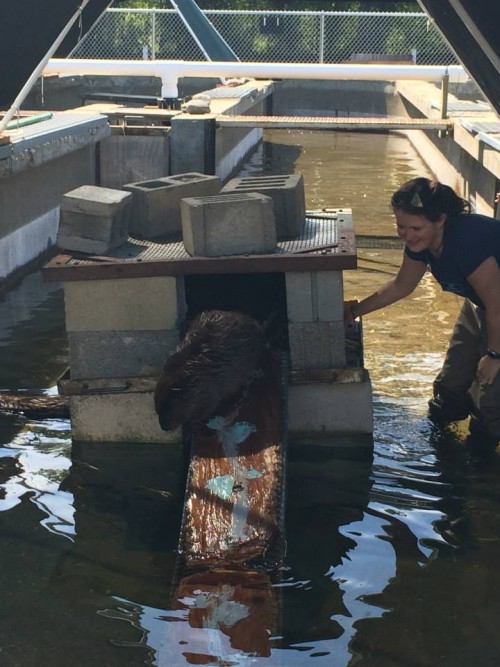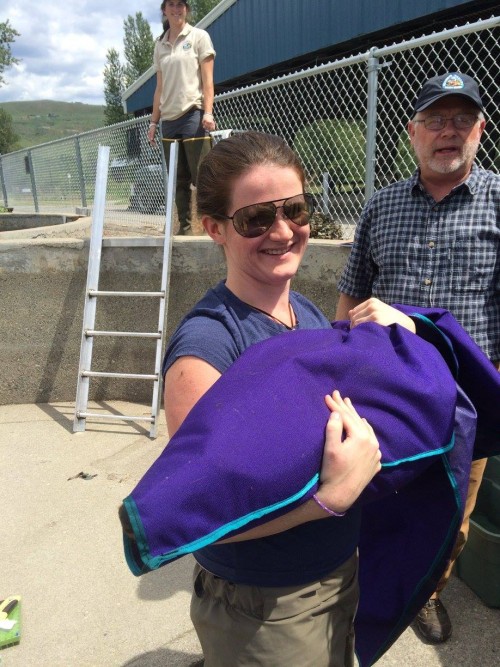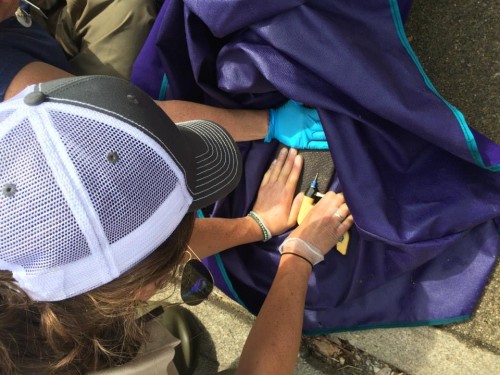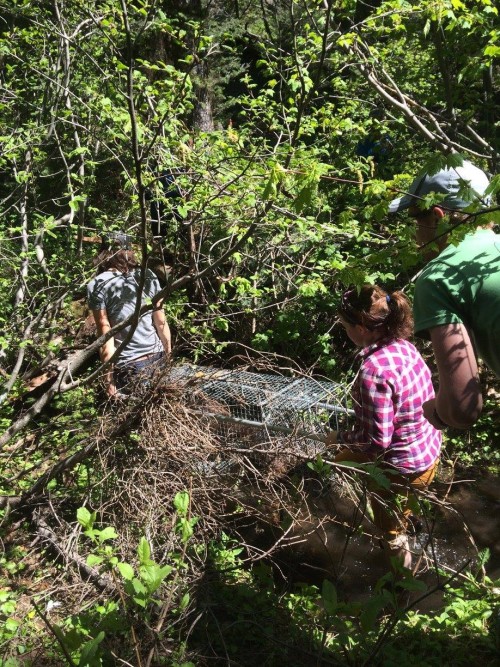Giving a "Dam": A Natural History of Beavers

By Liz Blackman, graduate student in the institute’s 14th cohort.
As I slide over the edge of the raceway and landed knee-deep in water I can barely see the almond-colored nose of the buoyant beaver as he floats beneath his cinderblock temporary home behind a large pile of aspen cuttings. He seems minimally threated by my presence, exhibiting none of the displays one would expect from a recently captured wild animal. No tailslapping or aggressive presentations as I slop through the water toward him, awkward and weighed down by the oversized boots and waders protecting me from the cool water. The closer I get the more aware I become of just how gentle this creature must be. We make eye contact before he dips his torpedo-shaped head beneath the water and begins to swim smoothly away from me toward the wall of the raceway. His waffle-pattered leathery tail is smaller than I expect and moves both vertically and horizontally as he alternately propels and rudders himself through the water. It takes only a few minutes of following Chuck around the raceway for him to swim directly into the cage being held in the water ahead of him. No wonder these animals were trapped nearly to extinction. In less than five minutes and with no struggle whatsoever the young male is securely caged and ready to give some third-graders an unrivaled first-hand experience with the country’s largest rodent. The musky smell of castor is unmistakable in the morning air and although entirely new to me, the scent quickly becomes familiar. I am hooked.
Beavers are nature’s most misunderstood rodents. Docile, diligent, tidy and familiar, Castor Canadensis does more to shape waterways and landscapes than any of their mammalian relatives and plays an integral role in the delicate riparian balance of Washington’s diverse ecosystems. Beavers have an ancient history with damns dating back over 10 million years and there are estimates of more than two hundred million beavers historically residing in the continental US. Indigenous American stories describe the beaver as co-creator of the land and sea alongside Great Sprit. Beaver appears in countless ancestral stories of Eastern Washington including the Confederated Tribes of the Coleville Reservation Upper Columbia River Book of Legends. Published in March 2007, the Coleville Book of Legends is full of references to the Beaver Tribe. Beaver is credited with a variety of great feats including stealing fire from the Sky People and bringing firewood to the tribes (How Beaver Stole the Fire) as well as marrying Coyote at Kettle Falls on the Columbia River and becoming the salmon chief (Why Coyote Changed the Course of the Columbia River).

Liz holding a beaver at the Methow Beaver Project.
The beaver played an integral role in the physical, cultural, economic and ecological development of the North American continent. According to Alice Outwater in her book Water: A Natural History, “until European colonization of the New World, Castor Canadensis, the North American beaver, was one of the most successful mammals on the continent, living almost everywhere there was water, from the Artic tundra to the deserts of northern Mexico…along thousands of streams, lived colony after colony, dam after dam of beavers in close succession, as many as three hundred dams per square mile, each with its own ring of wetlands.”
Eventually cultural interpretation of the beaver shifted to both commodity and pest following European colonization and the joint influences of the expansive European fur trade and later American agricultural progress. The beaver was nearly eradicated from the continental United States by the early 1900s. Beaver fur, a major motivating force behind Westward expansionism, became a form of currency during the fur trade era in the Pacific Northwest, with all tradable goods weighted according to their comparative value as it related to beaver. Beaver fur, used to make everything from fashionable European hats to winter coats, is both water resistant and incredibly durable and therefor extremely valuable.

My own natural history is inextricably linked to that of the beaver and a year ago I began working to envision a natural history project that ultimately brought this interrelationship to light in some incredible ways. By May 2015, I was able to spend time working directly with beaver reintroduction in Eastern Washington. The Methow Beaver Project led by Kent Woodruff, is an interagency collaboration working to restore the dynamism and complexity of the Methow watershed through the reintroduction of beavers. According to the Methow Conservancy’s EcoTrust Whole Watershed Restoration Project Completion Report released in 2009,
The last 200 years of Anglo settlement and land use transformed the Methow watershed, like most in the west, from a dynamic and complex system of streams and rivers into a relatively static, simplified system. One of the sources of stream system simplification in the Methow watershed was the intense trapping of beaver populations (Poole et al. 2001) that began here in the in the early 19th century. By some estimates, 90% of beaver populations were removed to supply the intense demand for fur in Europe and to create a “fur desert” to discourage colonization of land controlled by Hudson’s Bay Company (Hammond 1993, Outwater 1996, Johnson and Chance 1974).
The Methow Beaver Project works to trap “nuisance” beavers from Okanagan County and surrounding communities that are in conflict with human inhabitants (usually agricultural) and then takes them to the Winthrop Fish Hatchery for holding and tagging before releasing within the Methow watershed.
Since 2008, over 250 beavers have been relocated to 60 or more sites in Washington making for quite the potential impact. And because beavers mate annually and have between 3-5 kits each year the potential impact on the Methow watershed is tremendous. Beaver reintroduction is exponentially more direct and affordable than traditional manual stream restoration methods. I saw these high-speed impacts first hand when I went on a series of ride alongside with the Methow Beaver Project team.
How effective beavers can be at restoring riparian zones.
My most profound surprise and connection with Castor canedensis came not from field observation and ride alongs but from my very direct hands-on experience assisting with beaver intake procedures at the Winthrop Fish Hatchery.
I worked with Kent Woodruff to help unload two caged beavers from a truck and move them into a covered pavilion of raceways so that we could weigh them. The beaver cages are premeasured so that the beavers can be weighed inside a cage and their weight accurately calculated. We then moved the beavers into an empty raceway and began extracting the first from its cage. The goal was to safely move the beaver from the metal cage directly into a conical beaver bag. The beaver bag serves to both calm the beaver and safely restrain it without anesthesia while the beaver is micro-chipped, sexed and tagged. Once the beaver was safely in the bag and being cradled in the lap of one of the wildlife biologists, another member of the team took a pre-loaded micro-chipping syringe and mapped out the appropriate microchipping location on the beaver’s fleshy tail. Beavers have vertebrae running halfway down their tail and large blood vessels in a “V” shape from the base to the center of their tail so locational accuracy is important when micro-chipping. Catherine identified the location on the tail by visually dividing the beaver tail into half lengthwise and then into six segments. She then found the middle of the second segment on one side of the tail in order to avoid both blood vessels and vertebrae. Once the location is selected it is swabbed with alcohol and the syringe is inserted at approximately a 30-degree angle beneath a scale of the beaver tail. After some resistance the syringe slid part of the way into the tail and the microchip was inserted. While I applied pressure to the tail to help stop the bleeding the person cradling the beaver turned it over so that the underside of the tail and cloaca were visible.
Beavers have no external sexual organs so determining the sex of a beaver can be very difficult. Recently a new method for sexing beavers has been employed using the beaver bag. The process begins with massaging the beaver’s abdomen near where ovaries would be found in other mammals. Two glands, one on each side, can be felt beneath the surface of the skin and one should be pressed and massaged in a downward motion until it protrudes from the cloaca. However, because beavers urinate, defecate and excrete castor from the cloaca it can be a messy process. Once the gland is fully protruding from the cloaca you can massage or milk this gland until it releases a milky substance. This secretion is then swabbed and analyzed according to color, smell and viscosity of discharge, a rather pungent process.

Liz helping to imput a microchip into a beaver tail.
This process’s efficacy is 99% and is now gaining popularity with other beaver programs around the country. Once the beaver is weighed, sexed, micro-chipped and ear-tagged (not performed during this intake), it is released into the raceway with at least one other beaver of the opposite sex. Kent jokes that he runs a Match.com for beavers and he often mixes and matches mixedgendered pairs to get the most chemistry and potential genetic diversity before relocation.
Cultivating an environmental ethic is not always about science or about wilderness adventure. Sometimes your environmental ethic swims into your arms smelling of Castor oil and weird cloaca secretions and steals your heart. I will never be without my heart link to Castor canedensis and I hope that each of you take time to appreciate the riparian wetlands and fertile valleys that our beaver ancestors have gifted us and remember to give a dam!

Liz helping to transport a beaver to a restoration site.
This is a portion of Liz’s Natural History Project as a graduate student at the North Cascades Institute. All of the previous natural history projects can also be found on Chattermarks.

